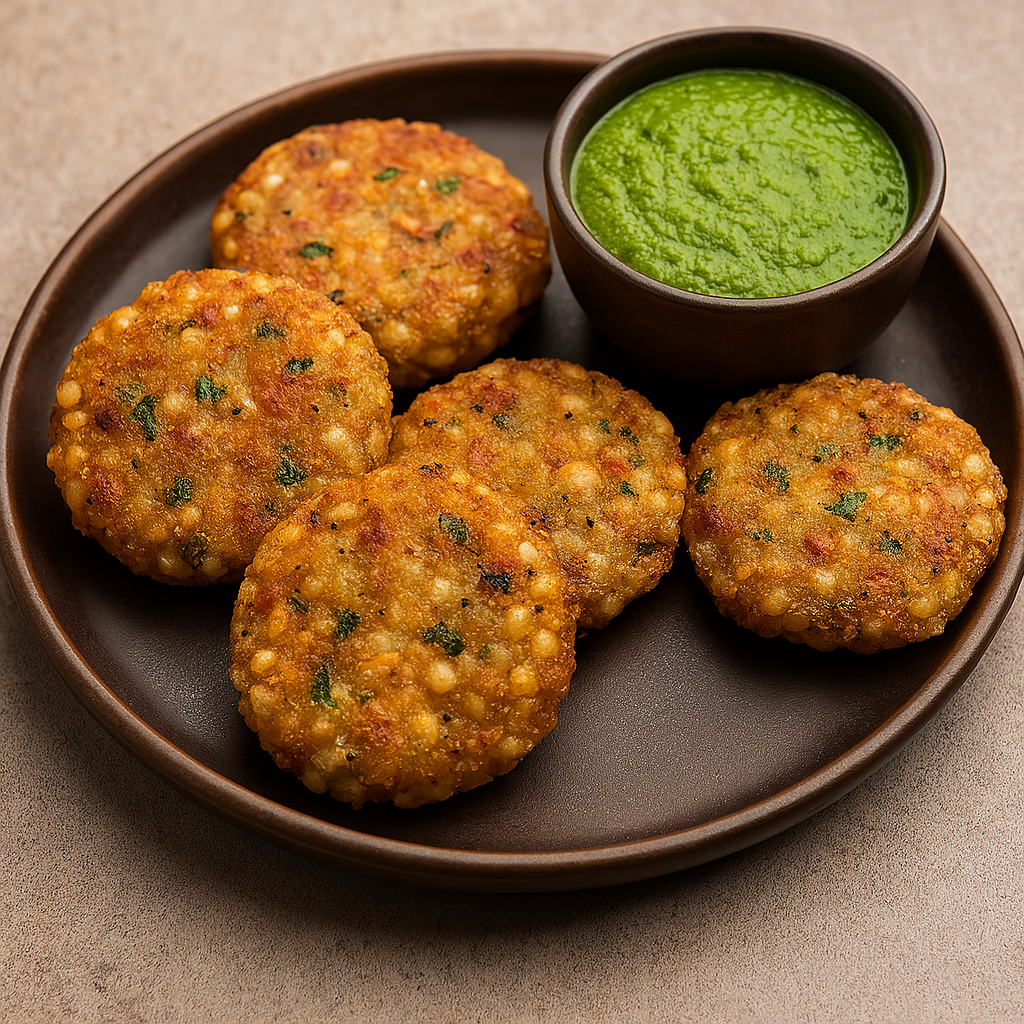Table of Contents
ToggleSabudana Tikki – A Delicious and Fulfilling Fasting Delight
Sabudana Tikki, also known as Sago Patties, is a popular Indian snack made using sabudana (tapioca pearls), boiled potatoes, peanuts, and mild spices. This crisp and flavorful delicacy holds a special place in Indian households, especially during religious fasting days like Navratri, Ekadashi, Mahashivratri, and other vrat (fast) occasions. While its crunchy exterior and soft interior make it irresistible, Sabudana Tikki is also cherished for its lightness, energy-boosting properties, and satvik (pure) nature.
Let’s dive deeper into the richness of this traditional snack — exploring its cultural relevance, ingredients, preparation, and health benefits.
Cultural & Festive Importance
Sabudana Tikki is especially consumed during vrat (fasting) periods when certain food groups like grains, onions, garlic, and certain spices are avoided. These fasts are not just religious practices but are seen as opportunities to detoxify the body and rejuvenate the digestive system. The ingredients used in Sabudana Tikki are carefully chosen to comply with these guidelines while ensuring nourishment and energy.
Among the various fasting dishes, sabudana preparations such as sabudana khichdi, sabudana vada, and sabudana tikki are the most loved. The soft and chewy texture of sabudana, combined with potatoes and roasted peanuts, creates a comforting and fulfilling experience that supports both devotion and health.
Main Ingredients and Their Role
Sabudana (Tapioca Pearls)
Sabudana is a starchy substance extracted from the cassava root.
It’s an excellent source of carbohydrates and provides a quick energy boost, which is ideal during fasts when meals are limited.
When soaked properly, sabudana becomes soft and gelatinous, acting as a natural binder in the tikki.
Boiled Potatoes
Potatoes serve as the main binding agent and add volume to the dish.
Rich in fiber, potassium, and carbohydrates, they help in feeling full and satisfied.
Roasted Peanuts
Coarsely ground peanuts add a nutty crunch to the tikkis.
Peanuts are protein-rich and enhance the nutritional profile of the dish, balancing the carbs from sabudana.
Green Chilies and Coriander Leaves
These ingredients bring a touch of spice and freshness to the dish.
They add flavor without the use of heavy masalas, which are usually avoided during fasting.
Sendha Namak (Rock Salt)
Used during vrat instead of regular iodized salt.
It is believed to be purer and easier to digest.
Ghee or Oil for Frying
Traditionally, ghee is used for frying to enhance taste and provide richness.
For a lighter version, oil or even air-frying can be used.
👩🍳 Preparation – How to Make Sabudana Tikki
Step 1: Soak the Sabudana
Wash sabudana 2–3 times and soak it in just enough water to cover it for 5–6 hours or overnight.
Drain excess water and ensure the pearls are soft and non-sticky when pressed between fingers.
Step 2: Roast the Peanuts
Dry roast peanuts and allow them to cool.
Peel off the skin and grind them coarsely — they should remain a bit chunky for texture.
Step 3: Mix the Ingredients
In a mixing bowl, combine soaked sabudana, mashed boiled potatoes, crushed peanuts, chopped green chilies, coriander, and sendha namak.
Mix gently until everything binds into a dough-like texture.
Step 4: Shape the Tikkis
Grease your palms with a little ghee or oil.
Take small portions of the mixture and shape into round, flat tikkis.
Step 5: Cook the Tikkis
Heat ghee or oil on a tawa or frying pan.
Place the tikkis and cook on medium heat until golden brown on both sides.
For a healthier version, they can be shallow fried or air-fried.
Step 6: Serve Hot
Serve Sabudana Tikki with vrat-friendly green chutney (made with mint, coriander, and lemon) or plain curd.
💪 Health Benefits of Sabudana Tikki
Great Energy Booster
The combination of sabudana and potatoes provides complex carbohydrates, ideal for sustained energy during fasting.
Improves Digestion
The fiber in potatoes and peanuts supports healthy digestion and prevents constipation during fasting.
Gluten-Free & Light on Stomach
Since sabudana is naturally gluten-free, it’s a perfect snack for those with gluten intolerance or a sensitive stomach.
Heart-Friendly (when shallow fried or air fried)
Using minimal oil and including peanuts, which are rich in healthy fats, makes the tikkis heart-friendly.
Rich in Minerals
Peanuts and potatoes add magnesium, potassium, and iron — minerals essential for nerve function and blood health.
Variations and Tips
Add grated sweet potato (shakarkandi) for a slightly sweet flavor and extra nutrition.
You can stuff the tikki with paneer or dry fruits for a royal vrat treat.
Avoid over-soaking sabudana, as it may turn sticky and make shaping difficult.
Always cook on medium heat to ensure even browning and crispy edges.
🌸 Conclusion
Sabudana Tikki is more than just a snack; it is a beautiful blend of tradition, taste, and health. Prepared especially during sacred fasting periods, it reflects the wisdom of Indian cooking — making food that supports both the body and the spirit. The crispy crust, soft filling, and aromatic bite make sabudana tikki a favorite for all age groups, whether they’re fasting or not.
From festivals like Navratri to everyday light snacks, sabudana tikki has earned its place in Indian kitchens as a trusted, versatile, and wholesome treat.

